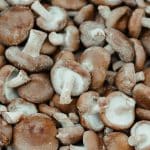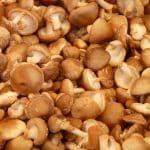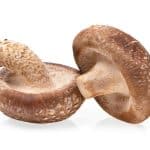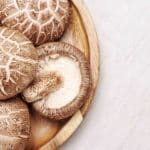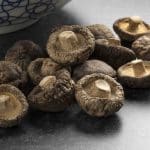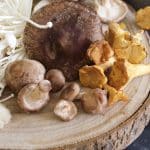It is a treat after a hard rain, walking in the woods to find mushrooms popping up from the trunks of trees, or between the fallen ones, or under leaves. Most of those mushrooms unfortunately are not edible. Although it’s really rewarding when you find the several varieties that are edible. Shiitake mushrooms are one of those delicious edible mushrooms.
About Shiitake Mushrooms
Shiitake mushrooms are delicious edible mushrooms found in eastern Asia, ubiquitous in Japanese and Chinese cuisine. It is now possible for people all over the world to grow these mushrooms in their homes, backyards, and, yes, even bathrooms. Growing Shiitake Mushrooms, as with all species of mushrooms, may feel a little strange for a long-time grower, if you have not grown them before. However, learning to do so is well worth it. These tiny caps mushrooms are well worth the trouble, because growing them, whether in a growing bag or on logs, can really reduce the costs.
You can find our favorite supplements containing Shiitake Mushrooms on the following page of our website to learn more.
Best Shiitake Mushroom Supplement
Lentinula edode is a brownish mushroom that has a 2 to 4 inch wide cap, and has a somewhat spindly, pale brown stem. The mushrooms cap may look slightly like a small pancake at times! There are little white spots on the edges of the cap. Underneath the cap are the galls, or what appear to be densely folded tissues, which make for an attractive pattern.
The common name Shiitake is derived from the literal meaning of the castanopsis mushrooms, from the Castanopsis cuspidata (also known as Shii Tree) tree, a species indigenous to Japan. While the mushroom does flourish naturally in most parts of eastern Asia, it does not do very well against mushrooms grown in other parts of the world, so it is very important that the logs or substrates that you are using as the hosts for growing your shiitake mushrooms are sterile. There are two major types of shiitake mushrooms, the donko, which is the larger mushroom and is most sought-after, and the koshin (Ko means tiny in Japanese), which is the smaller mushroom that has thinner flesh and a gaping cap.
While gardeners might find that wild mushrooms appear seemingly overnight in their backyards (especially following a new application of compost), they might be surprised to learn that growing Shiitake mushrooms can be a rather lengthy process. If grown on a sawdust substrate, mushrooms will take several months to mature from inoculation to harvest. If growing in a log substrate, harvests can be expected up to 2 years later, yes, you read that correctly, 2 years.
How to Grow Shiitake Mushrooms
The good news is you can begin growing Shiitake mushrooms in your backyard or greenhouse, particularly if you own the shiitake mushroom grow kit, and harvest them when they emerge from the grow kit.
Growing mushrooms is slightly different than growing herbs or other vegetables in your own backyard. But it is an interesting process, and it is a great way to get new gardeners involved with growing food themselves. Once you have an idea of some of the steps involved, you will find that growing Shiitake mushrooms is really pretty easy.
Years ago, people were able to grow shiitake mushrooms only in forests of east Asia. However, we have made great strides, and can now grow them all over the world. They are becoming so popular that an estimated 25% of annual mushroom production is Shiitake mushrooms.
With flavors that are reminiscent of wild mushrooms, packed full of that profound umami flavor, this tiny mushroom is well worth your time. A bit larger than a button mushroom, and packed full of vitamins, they claim that this one may boost your immune system. Shiitake mushrooms are basically unlike anything else in your garden when it comes to growing habits.
They are spores of a mushroom, which lie dormant until they find an appropriate environment in which to grow. To help these little guys come back to life, you are going to have to make a home that allows fungus spores to grow and multiply. This growing medium is typically either a fresh log or sawdust substrate.
With the rise of online retailers selling various types of inoculated plugged starter cultures, growing Shiitakes at home has never been easier!
Here’s a quick video summarizing the process, and we get into additional details below:
Best Shiitake Mushroom Substrates
In their natural habitat, you will find shiitake mushrooms growing in decomposing logs in Eastern Asia (specifically, the logs of the shimi). These areas are usually shaded from the tree canopy, and are extremely moist.
To mimic nature, two methods are usually used for growing mushrooms. You can either add fungus plugs in the trunk of a hardwood tree and harvest after 6-7 years, or you can grow in a growing bag and inoculate with a mix of sawdust and grits, achieving harvests much earlier.
Growing Shiitake Mushroom on Logs
Growing mushrooms on wood chips is an excellent choice for gardeners with access to forested areas, or for those growing mushrooms to sell. Freshly cut trees, such as an oak, during the late winter are a great option. You might find starting your inoculation early spring also yields better results with this tasty mushroom.
Gardeners should begin with a log recently felled. As weird as this sounds, this is an essential step. It is essential that you use a log or branch you just cut, roughly 3-6 inches across, rather than one that has been sitting around for more than two weeks.
The reason for this is the mycelium needs a start to colonize its new home. Since Shiitakes are bad at competing with wild mushrooms outside their home environment, they need a clean slate, and a new log provides it.
If you are taking your time growing on logs (called a bolt), you want the logs about 3-4 feet long. The length of one log should be the length of all of your logs.
For the choice of wood, the best is Castanopsis cuspidata, which is indigenous to it, but you could also go with oak, beech, maple, ironwood, alder, or poplar, if that is not available. Be sure to use hardwoods such as oak, since mycelium struggles in softwoods, particularly fruit trees and pine.
Growing Shiitake Mushrooms in Sawdust
For those gardeners looking for smaller crops or a quicker crop, the best option is to grow on a block of wood chips. These densely packed blocks of fungal culture will yield 4-6 harvests over the course of a year, and they are able to be managed by growers of any skill level.
After one year, though, you will have to start over from scratch. If you don’t want to stir in spores on your own, you can even order them online and get right into the fruiting phase. This is a great option for those looking to give it a shot before they commit to the whole lifecycle process. Kits offer a simple starter option for a new mushroom farmer.
Growing in these blocks is an excellent choice, as although mushrooms do not require logging, they need cellulose, which is typically found in logs. This cellulose is present even in the wood chips. Also, like with timber, hardwood sawdust is highly favored.
In addition, many find that mixing in rice bran, oat bran, or straw yields larger, more flavorful crops. Some common recipes are: 95% wood chips, 3% rice bran, 1% wheat bran, and 1% gypsum, or 75% wood chips, 24% straw, and 1% gypsum. Before you pitch, you need to pasteurize the mixture and whatever else you are adding to the sawdust recipe.
Often, you use a pressure cooker to get your temperatures right. Alternatively, you may want to simmer your mixture for one hour to get a similar results. Pasteurization is achieved at temperatures of 160-180° (temperatures that are similar to cooking meat to completion).
This removes most, but not all, of the living microorganisms from your substrate to prevent contamination. Be sure to let your substrate cool down to a uniform temperature (about 70°) before adding your inoculant. If you add an inoculant when it is too warm, there is a good chance that you will kill it by accident.
Inoculating Your Shiitake Mushrooms
To allow Shiitake Mycelium to spread through the entirety of the new habitat and fully colonize it, so that the mushrooms can be produced later, you need to inoculate the growing media. By inoculating, you are injecting shiitake spores into its new home, and doing so in such a way that you prevent accidental addition of wild spores too. There are two basic methods for inoculating the growing environment.
For cutting logs, a small hole is typically cut in the side of the timber, a small blob containing inoculants is placed inside, then covered with wax. These Shiitake logs are then laid down one atop another as they grow. If growing in wood chips, the inoculant is typically broken up into smaller pieces and mixed evenly throughout the growing medium.
Once you decide which inoculant you want, get one. You can keep the substrate or a spawn plug in a refrigerator as you wait for the best conditions for the inoculation of the substrate. Since adding fungus spores into the growing media is most critical when the growing environment is sterilized, plan ahead. You can definitely store the spores in the refrigerator for one week as you wait to begin your process come Spring.
How to Inoculate Logs with Shiitake Spores
Once you get hold of a fresh-cut log (4 feet long is best). With a good power drill, using a special bit to drill through wood shavings while drilling, punch holes an inch deep, about 2-3 inches apart, sequentially. Make sure that your drill bit is sterile to prevent any pathogens from entering your mushroom logs.
Start the second row of holes, which are arranged in staggered rows in between the initial holes. You will eventually have holes that are arranged like diamonds, thereby maximising the amount of space. Continue drilling holes throughout the entire log.
Once your holes are bored, you are ready to add in your Shiitake Mushroom spawns, either in the form of a fungus plug, or in the form of a Sawdust Spawn. If using plugs, simply insert each plug into the hole and cover it up with wax. If using contaminated wood chips, insert wood chips into a hole using the contaminated tools.
A mushroom inoculation tool is relatively easy to find on the internet. On average, one cutting of logs may need to use 30-40 caps per 4 foot long log. Once the logs are inoculated, they are sealed in beeswax, paraffin, or cheese wax.
Once cheese wax or another wax has sealed over the inoculated logs, mycelium has a greater chance of colonizing entire logs, and logs are able to retain more of their moisture content. Use the softer wax if possible, since it is easier for the younger fungi to force their way in. Using pre-made caps is usually the easiest way for the novice mushroom grower. These plugs are already rigged up with your desired Shiitake mushroom growth, and just a couple taps ensures that your plugs are positioned exactly where they should be. If you have excess plug left over, you can cut it off cleanly using an angle grinder, then cover with wax.
How to Inoculate Sawdust with Shiitake Spores
Another technique that is available for producers is using wood chips in place of logs. Inoculating this substrate is a little easier as well, provided the correct tools are used. Once you have got the pasteurized substrate, it needs to be mixed evenly with inoculated sphagnum. Before mixing, be sure the container in which you are mixing, as well as any tools that you are using, are sterile.
Gloves, or really well-washed hands, are crucial at this stage.
Once your substrate has cooled down from pasteurization, stir in the spawned sawdust well. It is important that you break your spawn down to the smallest size pieces you can, because this will allow for more uniform mixing into the substrate. Mix thoroughly, then put the substrate in a sterile bag to be plated. An even spread of the starters will result in rapid colonization.
Alternatively, you may also want to use a fungus spawn as plugs for suffocating the growing bags. However, since they are larger pieces, this will take longer to colonize the bags because the spawn is not distributed evenly across the substrate.
Shiitake Mushroom Colonization
Once it is inoculated, the mushroom needs to propagate, or race, across its new hosts before it can fruit.
With trunks, this may take as long as a year, while with wood chips, it is slightly shorter, 8 to 12 weeks.
Meanwhile, your mushrooms logs or substrate needs to stay uniformly moist. Avoid your log or substrate from drying out at all costs.
For mushrooms, lay them out flat on the ground in your woods, a greenhouse, or other shaded area, approximately 6 inches above the ground. If you leave logs close to the ground for months at a time, they will automatically get exposed to the increased moisture coming from the ground.
Wait until colonization has taken place. You will know that is happening when the edges of the log start having white spots. This growth typically starts at the center and grows outward. Once they are a year of colonization, they can then be placed into cribs, which are stacks, two on top of each other, forming a box.
Make sure that your crib is not covered with plastic or another impermeable fabric. They need to have airflow and humidity. A burlap cloth or similar is acceptable for keeping them from sun. Also, keep them out of strong winds or too much sun, because this too will dry the tree and stop it from producing fruiting bodies.
If during this period, you notice your logs are drying out, throw the logs in a water source such as a creek or pond, or rinse them repeatedly in just a few hours. Keeping your wood evenly wet is critical. For logs, this period is called a Spawn Run, because a Spawn forms a spiderweb, or runs, through a log, and slowly, but surely, makes it home.
This may take anywhere between eight months to two years, but is well worth the wait. For those looking to grow mushrooms in bags of sawdust, a single run of the spawn takes a lot less time. It should take just around 8-12 weeks for a block to change from light brown to a successful color.
Once it gets that stage, it is ready for harvest.
How to Initiate Fruiting of Shiitake
A shiitake that is completely populated with a log or a sawdust bag is waiting for the rain to come so that it will start to fruit and grow it’s fruiting body of mushrooms. Since growers have access to running water, this process can be spoofed to make the shiitake mushrooms speed up and yield sooner. This step is called shocking the shiitake bud into producing earlier.
For those growing with shiitake logs, the best practice is to immerse the logs in cold water for a 2-3-hour period after they are completely encapsulated. This can be done in a lake, a tub, or even in the trough. Make sure that the water is cold enough to keep spawning from dying, room temperature to cold is best.
This should result in the Shiitake Logs ripening in about 7-14 days. At this point, start watching out for slugs, which may be your biggest threat to your shiitake harvest. For mushrooms grown on substrate, you will need to follow a similar process.
Using a bucket or a large bowl, place the mushroom growing bag into cold water and leave for 2-3 hours. It is important to keep the water from being chlorinated, though, because this can kill the spores. Use filtered water, or water that has been left out for 24 hours (to allow the chlorine gasses to escape from the water) to soak the bags of your Shiitake Mushrooms.
Once the surface of your base begins developing a few budlets, it means that it is nearly time for your mushrooms to start growing. The next step is to remove the substrate entirely from the bag in order to promote airflow. It needs to stay together as your substrate is colonizing as your Shiitakes are popping their way out.
How to Harvest Shiitake Mushroom
Once you shake up your shiitakes, watch them grow. They will grow quickly during this phase. Once mushrooms are present and developing gills at the bottom of the mushrooms caps, it is time to harvest.
Cut it from a log or a substrate using a clean, sharp knife, being careful to avoid damaging your growing environment in any way. This is because Shiitake mushrooms can be harvested several times. Shiitakes grown on logging can keep producing for 6-7 years, while those grown on a substrate can produce 4-6 times for each new batch of sawdust.
Once you harvest your shiitakes, either use them immediately or store in a brown paper bag in your refrigerator. They should be kept cool and dry, and they will last for about one week in the refrigerator. Alternatively, you can freeze or dry them to keep for longer periods.
What to do With Spent Substrate After Growing Shiitake Mushrooms
A spent shiitake log or base still has plenty of life left, but may no longer be suitable for growing mushrooms. Gardeners will recognize spent fungus substrates as great compost to add to their gardens. There are just some flowering shrubs, gardenias, camellias, and hydrangeas, that dislike mushroom compost. But otherwise, spent shiitake mushroom substratum is garden gold!
Large amounts of the substrate need to weather in the open for several months on a mound, to allow salts to leach from it, before being applied to your vegetable and fruit crops. Small amounts may be mixed evenly in new garden beds or added to the bins with the worms. You might even find yourself growing Shiitake mushrooms by accident directly on the top of a worm bin! Also, you may want to add some soil on top of a freshly planted lawn, since sterile yet nutritious material will hold moisture and nourish a new lawn.
For stumps that have survived through 6-7 years of fruiting and are still undamaged, consider burying them in a new garden plot or in an area you are planning on growing soil. They will decompose and provide needed nutrients for soil in years to come.
Additional Resources:








